Lille tornado øger ydeevnen af elektrospray-ioniseringsmassespektrometri

DRILL-enheden er forbundet til et massespektrometer for at sortere ladede dråber og forbedre desolvation af ioniserede biomolekyler til analyse. Enheden kræver ingen ændring af massespektrometeret, og kan rummes inden for den standard arbejdsgang, der nu bruges af forskere. Kredit:Rob Felt, Georgia Tech
Tilføjelse af ækvivalenten til en miniature tornado til grænsefladen mellem elektrospray-ionisering (ESI) og et massespektrometer (MS) har gjort det muligt for forskere at forbedre følsomheden og detektionsevnen af den meget anvendte ESI-MS analytiske teknik. Blandt de videnskabelige områder, der kunne drage fordel af den nye teknik, er proteomik, metabolomics og lipidomics - som tjener biomedicinske og sundhedsmæssige applikationer lige fra biomarkørdetektion og diagnostik til lægemiddelopdagelse og molekylær medicin.
Kendt som Dry Ion Localization and Locomotion (DRILL), den nye enhed skaber et hvirvlende flow, der kan adskille elektrospraydråber afhængigt af deres størrelse. I denne ansøgning, en af mange potentielle anvendelser for DRILL, de mindre dråber ledes ind i massespektrometeret, mens de større – som stadig indeholder opløsningsmiddel – bliver i hvirvelstrømmen, indtil opløsningsmidlet fordamper. Fjernelse af opløsningsmidlet muliggør analyse af yderligere ioner, der kan gå tabt i de nuværende teknikker, og reducerer den kemiske "støj", der hæmmer massespektrometerets selektivitet.
"En stor udfordring for at detektere små mængder biomolekyler ved hjælp af massespektrometriteknologi er, at vi ikke kan se alt, hvad der faktisk er i prøven, " sagde Matthew Torres, en assisterende professor ved Georgia Tech's School of Biological Sciences. "DRILL-enheden giver en ny måde at løse det problem på ved at øge antallet af ioner, vi kan få ind i massespecifikationsinstrumentet, så vi produktivt kan detektere dem. Ionerne er der nu, men ikke nødvendigvis i en form, som massespecifikationen kan håndtere."
Udviklet af forskere ved Georgia Institute of Technology med støtte fra North Carolina State University, DRILL kan tilføjes til eksisterende elektrospray-ioniseringsmassespektrometre uden at ændre dem.
"Princippet er at få dråberne til at rotere og bruge inerti til at adskille dem efter størrelse, " forklarede Andrei Fedorov, en professor ved Georgia Tech's Woodruff School of Mechanical Engineering. "Vi ønsker, at dråberne skal forblive i strømmen længe nok til at fjerne opløsningsmidlet. I praksis mindre dråber forbliver i midten, hvor de er, kan fjernes først til analyse, mens de større forbliver på kanten af strømmen, indtil de er tørret."
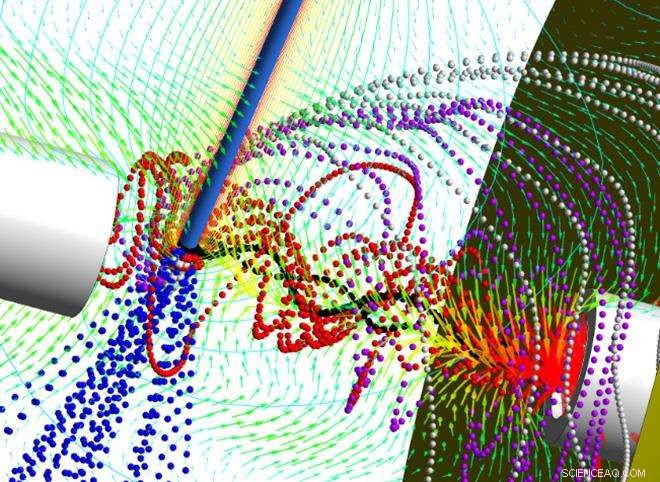
Dette skema repræsenterer, hvordan DRILL-enheden fungerer, når den transmitterer ioner til massespektrometeret ved hjælp af en omhyggeligt designet vortex-flow. Kredit:Peter Kottke, Georgia Tech
Nøgleidéen til DRILL er baseret på Fedorovs opfindelse fra 2007 "Indskrænkning/fokusering af Vortex Flow Transmission Structure, massespektrometrisystemer, og metoder til at transmittere partikler, Dråber, og ioner." (US patent nr. 7, 595, 487). I de seneste tre år har DRILL-enheden er udviklet med støtte fra National Institute of General Medical Sciences fra National Institutes of Health, og dens seneste version blev beskrevet 14. juni i tidsskriftet American Chemical Society Analytisk kemi .
Ved elektrospray-ionisering (ESI), et elektrisk potentiale påføres en opløsning inde i et kapillar, frembringer et stærkt elektrisk felt ved spraykapillærspidsen. That leads to the expulsion of an aerosol containing charged droplets that carry the molecules to be analyzed. The ejected droplets then break up into smaller droplets, creating a plume that expands spatially beyond the inlet intake capacity of the mass spectrometer, resulting in sample loss. The DRILL device provides an effective interface for collection and transmission of charged analytes from ionization sources, such as ESI, to detection devices, such as mass spectrometers, resulting in significantly improved detection capability.
As much as 80 to 90 percent of large biopolymers (proteins, peptides, and DNA) are currently lost to analysis using existing ESI-MS techniques, which have grown in importance to the life sciences community. Capturing all of the biopolymers could lead to new discoveries, said Torres, whose lab studies post-translational changes in proteins. By allowing analysis of large biomolecules, DRILL could facilitate top-down proteomics in which complete protein molecules could be studied without the need to enzymatically break them up into smaller pieces before MS analysis.
"This could allow us to see combinatorial modifications that exist on a single protein molecule, " said Torres. "It's very important for us to understand how proteins communicate with one another, and DRILL may allow us to do that by more effectively removing the solvent from these types of samples."
The Georgia Tech researchers are using DRILL in their lab to interface between liquid chromatography and the ESI-MS instrument. Multiple electrodes and inlet/outlet ports enable precise control over the flow generation and guiding electric field inside the DRILL, so the device can be configured for a variety of uses, Fedorov noted. In a general sense, DRILL adds a new approach for manipulating the trajectory of charged droplets, hvilken, when combined with hydrodynamic drag forces and electric field forces, provides a rich range of possible operational modes.
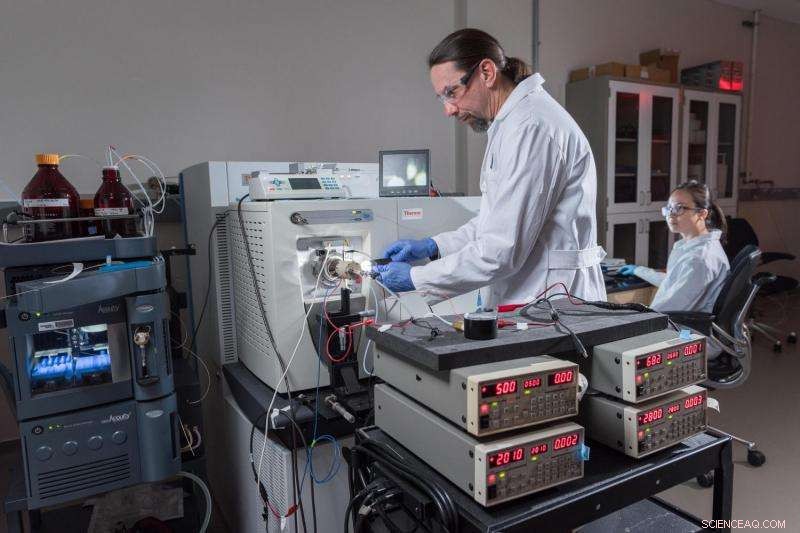
Research Scientist Alex Jonke (left) connects DRILL to a mass spectrometer in the Torres laboratory at Georgia Tech, while Graduate Research Assistant Jung Lee prepares to collect mass spectra resulting from the analysis. Kredit:Rob Felt, Georgia Tech
DRILL can improve the signal-to-noise ratio by a factor of 10 in the detection of angiotensin I, a peptide hormone, and boost the sensitivity for angiotensin II ten-fold to picomole levels. DRILL demonstrated improved signal strength – up to 700-fold – for eight of nine peptides included in a test extract of biological tissue.
DRILL could potentially allow the study of entire cell contents, analyzing thousands of different molecule types simultaneously. That could allow researchers to see how these molecules change over time to detect problems in chemical pathways and to determine why drugs work in some people and not others.
"This could be a huge advance for biologists and others who are interested in protein biochemistry and cell biology because it enhances the sensitivity of the analytical technical and overcomes a major hurdle in studying large biological molecules, " Torres added. "We expect to be able to see things we haven't been able to see before."
The Georgia Tech researchers have been collaborating with David Muddiman, a professor in the Department of Chemistry at North Carolina State University, on developing DRILL and its analytical characterization using state-of-the-art mass spectrometry experiments. A unique contribution of the North Carolina State University researchers is in using a powerful statistical method called "design of experiments" to guide the multi-parameter optimization of the DRILL device, resulting in identification of a sweet spot for optimal operation.
Fedorov and Torres hope to expand use of the DRILL device beyond Georgia Tech laboratories and further enhance its design. Among the near-term improvements planned is the addition of internal heating to accelerate the removal of solvent. "We see many additional improvements that will allow DRILL to further enhance the ESI-MS process, " said Fedorov. "We plan to continue evolving it as more labs start to use the device."
 Varme artikler
Varme artikler
-
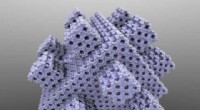 Bryde molekylære trafikpropper med finnede nanoporøse materialer3D-finnede zeolitkatalysatorer forbedrer molekyladgang til det indre af partiklen. Kredit:J.C. Palmer Tusindvis af kemiske processer, der bruges af energiindustrien og til andre anvendelser, er af
Bryde molekylære trafikpropper med finnede nanoporøse materialer3D-finnede zeolitkatalysatorer forbedrer molekyladgang til det indre af partiklen. Kredit:J.C. Palmer Tusindvis af kemiske processer, der bruges af energiindustrien og til andre anvendelser, er af -
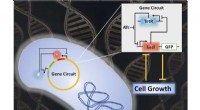 Forskere afslører nye forståelser af syntetiske genkredsløbTian og Wangs forskning afslører ny indsigt om de komplekse forhold mellem syntetiske genkredsløb og cellerne, der er vært for dem. Kredit:Xiaojun Tian/ASU Nylige opdagelser fra to forskerhold i I
Forskere afslører nye forståelser af syntetiske genkredsløbTian og Wangs forskning afslører ny indsigt om de komplekse forhold mellem syntetiske genkredsløb og cellerne, der er vært for dem. Kredit:Xiaojun Tian/ASU Nylige opdagelser fra to forskerhold i I -
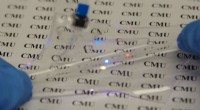 Usynlig, strækbare kredsløb for at forme næste generations teknologiSkærmene og berøringsskærmene, der bruges i næste generations teknologier, kræver gennemsigtige ledere, der er bløde, elastik, og meget strækbar. Kredit:Soft Materials Laboratory, Carnegie Mellon Univ
Usynlig, strækbare kredsløb for at forme næste generations teknologiSkærmene og berøringsskærmene, der bruges i næste generations teknologier, kræver gennemsigtige ledere, der er bløde, elastik, og meget strækbar. Kredit:Soft Materials Laboratory, Carnegie Mellon Univ -
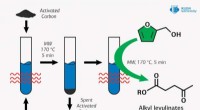 Chemist foreslår ny måde at forbedre brændstofkvaliteten ved hjælp af mikrobølgebestrålingKredit:RUDN Universitet En kemiker fra RUDN University har fundet en miljøvenlig måde at opnå estere af levulinsyre, der bruges som brændstoftilsætningsstof til kemisk syntese. Sammen med kolleger
Chemist foreslår ny måde at forbedre brændstofkvaliteten ved hjælp af mikrobølgebestrålingKredit:RUDN Universitet En kemiker fra RUDN University har fundet en miljøvenlig måde at opnå estere af levulinsyre, der bruges som brændstoftilsætningsstof til kemisk syntese. Sammen med kolleger
- Flaskevandsindustrien har en sund oprindelse
- NASA finder kraftig regn sydvest for den tropiske cyklon Uesis center
- Hvorfor verden skyldes en revolution inden for økonomisk uddannelse
- Fra atomer til planeter, det længstvarende rumstationseksperiment
- John Glenn hædret med opsendelse af rumstationsforsyningsskib
- Genopladelige magnesiumbatterier med høj hastighed bevæger sig et skridt tættere på realiseringe…


